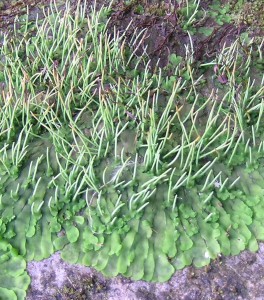As a follow-on to my post about why bryophytes are important is this thoughtful piece by Dr Janice Glime, author of the comprehensive and freely downloadable book Bryophyte Ecology:

Leiosporoceros dussii: Photographed by Juan Carlos Villarreal, this phylogenetically isolated hornwort grows over huge expanses on an open cliff in Valle de Antón, Panama
In some ecosystems, bryophytes are much more important than in others, but in most systems they are important in many ways. They house a wide range of invertebrates, provide safe sites for many, provide a place for isopods to get moisture or to lose excess. They insulate the soil, ameliorating the temperature and protecting fine roots. They release nutrients to soil in late summer in some ecosystems when the nutrients are lowest, giving trees and shrubs a boost. They are important seedbeds for trees like hemlock. In the tropics they house many endangered salamanders and tree frogs. They control erosion, especially immediately after disturbance. In the Arctic the climate model worked much better after the bryophyte component was included because they have a significant impact on climate there, and they are especially important in the water cycle. Their moisture can reduce or eliminate the effects of groundfire.
Their potential for use in medicine can be huge, as can be seen in Asakawa‘s research. These are organisms that have survived eons by developing secondary compounds to fight the ever-increasing number of diseases and herbivores, and these have been shown to have anticancer properties.
They help to lock up pollutants that could harm us and don’t easily release them. They are essential in the life cycle of the Chinese gall nuts. They are used in many kinds of bird nests and in some cases may protect the birds from parasites and other pests. In other cases they seem to help in controlling nest temperature.
Their contributions are subtle, but can be quite important.
Dr. Janice Glime, Professor Emerita (Michigan Technological University) Manager of Bryonet, Past President of IAB
